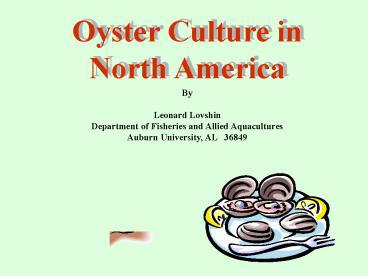Oyster Culture in North America - PowerPoint PPT Presentation
1 / 24
Title:
Oyster Culture in North America
Description:
... from Japan and extends from Alaska to Baja California ... Oysters are sold live, fresh and frozen on the half shell and shucked, canned and smoked. ... – PowerPoint PPT presentation
Number of Views:184
Avg rating:3.0/5.0
Title: Oyster Culture in North America
1
Oyster Culture in North America
By Leonard Lovshin Department of Fisheries and
Allied Aquacultures Auburn University, AL 36849
2
The American Cupped Oyster, Crassostrea
virginica, is native to the East coast of Canada
and United States, Gulf of Mexico and Caribbean,
and as far south as the Northern coast of South
America.
The Pacific Cupped Oyster, Crassostrea gigas, is
introduced from Japan and extends from Alaska to
Baja California
3
Feeding Habits feed on phytoplankton and
detritus by filtering from the water. Water
temperature 25 to 30oC for best
growth Salinity 10 to 22 ppt for best growth
Growth to 15 cm 9 to 12 months in the Gulf of
Mexico
4
- Life History
- Reach sexual maturity at 1 year of age.
- 2. Young oysters are male but change to female
after first spawning season.
3. Water temperatures above 25oC trigger spawning
in the Gulf of Mexico. 4. Salinity above 10
ppt. 5. Spawn between March and November
Larval period is 14 to 21 days
5
Sperm triggers females to release eggs. Females
can release millions of eggs.
Larvae with a muscular foot looking for a site to
set.
sperm
6
Oyster Farming 1. Seed Production - wild
Seed can be collected from the wild on shells and
artificial substrates ( cultch ) placed near
spawning grounds.
7
1. Seed Production - hatchery
Adults are induced to spawn and the larvae are
fed algae until they are ready to set.
8
Triploid oysters that can not reproduce are
produced in a hatchery. Triploid oysters grow
faster than normal diploid oysters and have good
flavor during the summer spawning season.
gonad
9
Larvae ready to set can be placed in upwellers
containing crushed shell or tanks with bags of
shell
tanks
larvae
upwellers
crushed shell
10
Spat on crushed shell are single set and spat on
whole shells are multiple or cultch set.
11
Nursery
Spat can be placed in protected intertidal zones
to grow and harden for several months.
Exposing the oysters to the air protects them
from predators.
12
Growout Cultch set oysters are grown 1. On
the bottom in reefs 2. On ropes suspended
off the bottom.
Shells with spat are moved from spawning or
nursery grounds to growout areas. Little care is
given to the oysters. Culture is extensive.
13
Growout 2. Cultchless or single oysters are grown
in
bags
trays
14
Growout Trays and bags are suspended off the
bottom by ropes tied to rafts and floats or on
stationary plateforms. Culture is extensive.
raft
plateform
floats
Oyster density and sizes, predators and fouling
are controlled.
15
Shaker table grader
Oysters are graded several times to assure
uniform growth and size at harvest.
Uniform sizes
Variable sizes
16
Predators are controlled by exposing the oysters
to air, keeping the oyster off the bottom and
manual cleaning.
starfish
black drum
crabs
oyster drill
17
Fouling organisms are removed by drying, pressure
spraying, manual cleaning and dipping in a toxic
solution.
cleaned
fouled
Fouling organisms compete for space and food with
oysters and restrict water flow through
enclosures
18
Harvest Reef oysters are harvested from the
bottom with tongs and dredges. Oysters are ready
for harvest in 1 to 5 years depending on water
temperatures.
19
Harvest Oysters cultured in bags, trays and on
ropes are harvested mechanically because of their
weight.
20
Purging Oysters are often contaminated by
bacteria and viruses harmful to the consumer of
raw oysters. Oysters can be purged by moving them
to clean water in the ocean or on land.
21
Oysters are sold live, fresh and frozen on the
half shell and shucked, canned and smoked.
Fresh on half shell
Frozen on half shell
22
World yield of whole oysters was about 3,944,000
mt in 2000
23
Wild and farmed harvest of oyster meat in the U.
S. in 1999 was 12,587 metric tons.
Harvest of American oyster meat was 9,109 mt or
72 of the total harvest. Harvest of Pacific
oyster meat was 3,478 mt or 28 of the total
harvest.
Meat is 10 of the whole oyster weight
24
THE END































